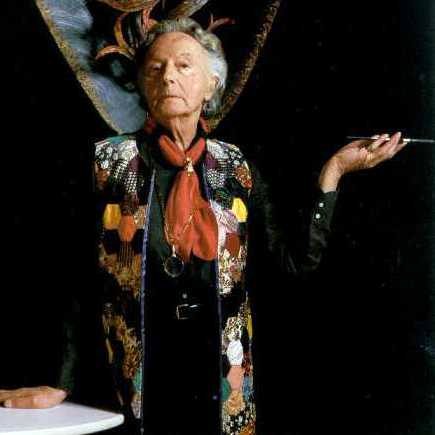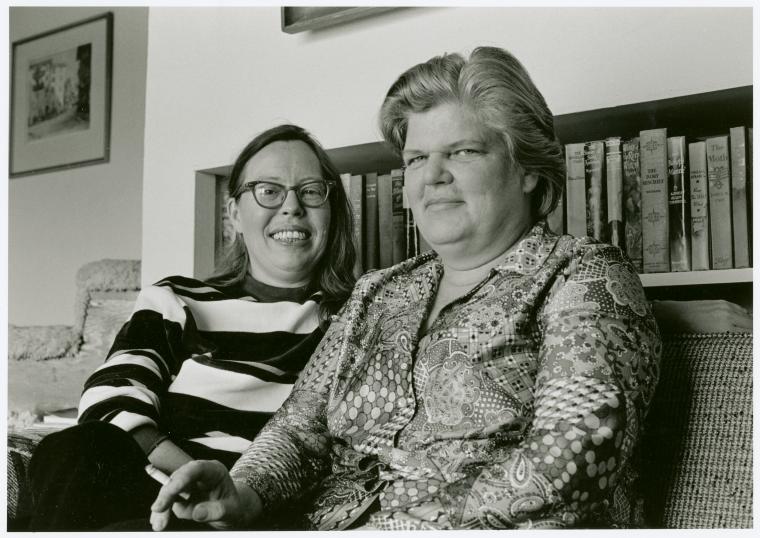|
Gay Wisdom for Daily Living brought to you by White Crane Institute ͏ ͏ ͏ ͏ ͏ ͏ ͏ ͏ ͏ ͏ ͏ ͏ ͏ ͏ ͏ ͏ ͏ ͏ ͏ ͏ ͏ ͏ ͏ ͏ ͏ ͏ ͏ ͏ ͏ ͏ ͏ ͏ ͏ ͏ ͏ ͏ ͏ ͏ ͏ ͏ ͏ ͏ ͏ ͏ ͏ ͏ ͏ ͏ ͏ ͏ ͏ ͏ ͏ ͏ ͏ ͏ ͏ ͏ ͏ ͏ ͏ ͏ ͏ ͏ ͏ ͏ ͏ ͏ ͏ ͏ ͏ ͏ ͏ ͏ ͏ ͏ ͏ ͏ ͏ ͏ ͏ ͏ ͏ ͏ ͏ ͏ ͏ ͏ ͏ ͏ ͏ ͏ ͏ ͏ ͏ ͏ ͏ ͏ ͏ ͏ ͏ ͏ ͏ ͏ ͏ ͏ ͏ ͏ ͏ ͏ ͏ ͏ ͏ ͏ ͏ ͏ ͏ ͏ ͏ ͏ ͏ ͏ ͏ ͏ ͏ ͏ ͏ ͏ ͏ ͏ ͏ ͏ ͏
|
|
||||
| This Day in Gay History | ||||
November 10Born 1879 - VACHEL LINDSAY, poet, born (d: 1931); His exuberant recitation of some of his work led some critics to compare it to jazz poetry despite his persistent protests. Because of his use of American Midwest themes he also became known as the "Prairie Troubador." Today, his poetry is no longer fashionable, which is too bad since it contains a rhythmic vitality that has all but gone out of contemporary cerebral poetry. He is probably best known for this poetic apostrophe to the Salvation Army in “General William Booth Enters Heaven,” although it is questionable whether he ever made it past the pearly Gates himself, since he not only liked boys too much by ended his days a suicide, both offenses that would remove his verses from today’s suburban libraries if the PTAs only knew. In his 40s, Lindsay lost his heart to the dazzlingly good-looking Australian composer and pianist, Percy Grainger, as had the Norwegian composer Edvard Grieg before him. Lindsay killed himself (horribly, swallowing Lysol) in 1931, the year before Hart Crane leapt into the sea. His only biography was published during the Eisenhower years, a decade before homosexuality was officially invented. If it took biographers almost a century to acknowledge Whitman’s Gayness, Lindsay should be due for a really serious biography around 2021. 1892 - Russian designer, ERTÉ, born (d: 1990); born Romain de Tirtoff, Erté is perhaps most famous for his elegant fashion designs which capture the Art Deco period in which he worked. His delicate figures and sophisticated, glamorous designs are instantly recognizable, and his ideas and art influence fashion into the 21st century. His costumes and sets were featured in the Ziegfeld Follies of 1923, many productions of the Folies Bergere, and George White’s Scandals. In 1925, Louis B. Mayer brought him to Hollywood to design sets and costumes for a film called Paris. There were many script problems so Erté was given other assignments to keep him busy. He designed for such films as Ben-Hur, The Mystic, Time, the Comedian, Dance Madness and La Boheme. Erté is virtually synonymous with Art Deco, which is unfortunate as his work represents the extreme of the style and not the style itself. It’s perhaps not an exaggeration to say that Erté’s creations made the most outrageous clothing designed by MGM’s Adrian look like nuns’ habits. Erté’s name can safely be added to that small list of gay male favorites – Judy Garland, Bette Davis, Angela Lansbury, Bette Midler – that either sends one swooning with rapture or jumping for cover behind the nearest sofa. 1913 - JAMES BROUGHTON poet, poetic filmmaker, and practitioner of “Big Joy,” a pan-sexual Dionysian approach to life, born. He’s been called "the father of the West Coast experimental film movement" in the wake of World War II, was part of the San Francisco Renaissance, a literary movement that included Kenneth Rexroth, Robert Duncan, Lawrence Ferlinghetti, and others. He was an early bard of the Radical Faeries. Despite many creative love affairs during the San Francisco Beat Scene, Broughton put off marriage until age 49, when, steeped in his explorations of Jungian psychology, he married Susanna Hart in a three-day ceremony on the Pacific coast documented by his friend, the experimental filmmaker Stan Brakhage. Susanna’s theatrical background and personality made for a great playmate; they had two children. They built a great community among the creative spirits of Alan Watts, Michael McClure, Anna Halprin, and Imogen Cunningham. In 1967’s “summer of love,” Broughton made a film, The Bed, a celebration of the dance of life which broke taboos against frontal nudity and won prizes at many film festivals. It rekindled Broughton’s film-making and led to more tributes to the human body ("The Golden Positions"), the eternal child ("This is It"), the eternal return ("The Water Circle"), the eternal moment ("High Kukus"), and the eternal feminine ("Dreamwood"). “These eternalities praised the beauty of humans, the surprises of soul, and the necessity of merriment,” Broughton wrote. God and Fuck belong together God and Fuck are so much alike from Special Deliveries by James Broughton published by Broken Moon Press But Broughton spent the greater part of his life with his life partner, artist, Joel Singer, with whom he made many films and traveled the world. He died in May, 1999 with champagne on his lips, in the house in Port Townsend, Washington where he, and Singer, lived for 10 years. Before he died, he said, “My creeping decrepitude has crept me all the way to the crypt.” His gravestone in a Port Townsend cemetery reads, “Adventure -- not predicament.” In 2006 White Crane Books published selected writings of Broughton edited by San Francisco poet and radio host, Jack Foley titled ALL: A James Broughton Reader [ISBN 1-59021-020-4] as part of the White Crane Gay Wisdom Series. It is available at www.gaywisdom.org (The Golden Positions), the eternal child (This is It), the eternal return (The Water Circle), the eternal moment (High Kukus), and the eternal feminine (Dreamwood). “These eternalities praised the beauty of humans, the surprises of soul, and the necessity of merriment,” Broughton wrote. God and Fuck belong together God and Fuck are so much alike from Special Deliveries by James Broughton published by Broken Moon Press But Broughton spent the greater part of his life with his life partner, artist, Joel Singer, with whom he made many films and traveled the world. He died in May, 1999 with champagne on his lips, in the house in Port Townsend, Washington where he, and Singer, lived for 10 years. Before he died, he said, “My creeping decrepitude has crept me all the way to the crypt.” His gravestone in a Port Townsend cemetery reads, “Adventure - not predicament.” In 2006 White Crane Books published selected writings of Broughton edited by San Francisco poet and radio host, Jack Foley titled ALL: A James Broughton Reader [ISBN 1-59021-020-4] as part of the White Crane Gay Wisdom Series. It is available at www.gaywisdom.org
1924 - PHYLLIS LYON, Lesbian activist, born; Phyllis Lyon was born in Tulsa, Oklahoma. She holds a degree in journalism from the University of California, Berkeley, earned in 1946. During the 1940s, she worked as a reporter for the Chico Enterprise-Record, and during the 1950s, she worked as part of the editorial staff of two Seattle magazines. Her name is now almost always paired with that of her partner, Del Martin. Martin and Lyon met in Seattle in 1950 when they began working for the same magazine. They became lovers in 1952 and entered into a formal partnership in 1953 when they moved to San Francisco together although technically unable to legally marry. On February 12. 2004, Martin and Lyon were granted the first marriage license given to a same-sex couple in the United States. The license was granted in violation of California state law by the City and County of San Francisco after mayor Gavin Newsom ordered that marriage licenses be given to same-sex couples who requested them. The licenses were voided on August 12, 2004. In 1955, Martin and Lyon and six other Lesbian women formed the Daughters of Bilitis, the first major Lesbian organization in the United States. In 1956, DOB issued a twelve-page, mimeographed newsletter called The Ladder, edited by Lyon. Within five years of its origin, the Daughters of Bilitis had chapters around the country, including Chicago, New York, New Orleans, San Diego, Los Angeles, Detroit, Denver, Cleveland and Philadelphia. There were 500 subscribers to "The Ladder," but far more readers, as copies were circulated among women who were reluctant to put their names to a subscription list. An accommodationist organization, soon to be closely associated with the Mattachine Society, a predominantly male homophile group, DOB became the first national Lesbian society; and The Ladder, the first overtly Lesbian journal, achieved national circulation. Because of the conservative climate of the 1950s, membership in DOB was secret, and Lyons used a pseudonym for her work on the first few issues of The Ladder. Martin took over editorship of the newsletter from 1960 to 1962, and was then replaced by other editors until the newsletter ended its connection with the Daughters of Bilitis in 1970. Lyon and Martin remained leaders of the DOB until the late 1960s, when they were replaced by women who were perceived as more radical and who had different goals for the organization. The Daughters of Bilities disbanded not long after Martin and Lyon's leadership ended Martin and Lyon have been active in the National Organization for Women (NOW) since 1967. Del Martin was the first openly Lesbian woman elected to NOW. Lyon and Martin worked to combat the homophobia they perceived in NOW, and encouraged the National Board of Directors of NOW's 1971 resolution that Lesbian issues were feminist issues. Today's Gay Wisdom 2017 - The Reverend Canon Malcolm Boyd…author of thirty books and one of the true elders of our community, had many different lives in his 85 years. Working in Hollywood in partnership with the legendary Mary Pickford, he became the first president of the National Association of Television Producing Executives and he left all that glamour and gold to become a priest. From Hollywood, he marched to Selma with Martin Luther King, gave poetry readings with Dick Gregory at the hungry I in San Francisco, and put it all on the line when he came out as a Gay man. He lived in Los Angeles where he was the Writer in Residence for the Los Angeles Episcopal Archdiocese, and became a regular contributor, along with his late husband, Mark Thompson, to White Crane. To celebrate Malcolm’s 85th birthday, White Crane Books published out A Prophet in His Own Land: The Malcolm Boyd Reader, a collection of the more than 50 years of writing from this wonderfully wise, kind, and deeply intelligent man. We asked him to think about the idea of “elder”. This is what he wrote: As an Elder, I remember what it was like to be a Gay kid in the 1920s and 30s and 40s. Because I knew my being "different" was not only objectionable but also unallowable, survival came into place. I never had a childhood because, from the very beginning, surviving meant playing a calculated role, never being open to attack, never letting down my guard, and trusting no one. Required was an acceptable public role played to perfection. High school meant being — not Gay at all — but a homosexual youth in a totally closeted culture. I ran with three other boys. We were outsiders, different, out of the mainstream. Also three of us, I realize now, were Gay. The fourth, quite outwardly effeminate, was the only non-Gay. We didn't date girls or even think of it. Albert, one of the three Gays including me, was quite mad in his behavior, a kind of young Orson Welles in manner, very gifted and creative. One night in the bedroom of his parents' home he placed a pistol in his mouth, pulled the trigger, and blew his head off. John — quiet, reflective with a lively sense of humor, shy, a sweetheart — later died in World War II. There was never anyone to ask questions about being Gay. The subject, in the first place, was forbidden — so there could be no counselor at school or church, no family member. TV wasn't around yet, but there was no mention of "us" on the radio or in the press. The only exception was an occasional, ugly scandal. In college one night, a group of students, including myself, was at a drive-in for a hamburger. We heard an uproar in the men's room. We were told some guys had a queer, a faggot, in there and were making him go down on them with blow jobs or else they'd beat him to a pulp. Everybody was laughing: weren't queers really lepers anyway? I remember this struck me as so sad, so unmanageable, so hopeless. Where and how could I find myself in this puzzle? To try and walk on a bridge between this and any vision of a Gay community seemed absurd, an utter fantasy. Yet I found the strangest subliminal connections. For example, reading Richard Halliburton's travel stories in the public library gave me a boner. It wasn't until decades later I learned Halliburton was a Gay man. I was reacting to, and awakened by, a Gay writer. At another time when I was very young I fell in love with the paintings of Rosa Bonheur in the Metropolitan Museum of Art in New York. I said she was one of my favorites. Years later I found out she was a Lesbian. In my youth I can remember a few individuals who, like tribal elders, reached out sensitively to me. They were kind and perceptive. I was then a highly nervous, energetic, creative, overly imaginative youth who was obviously on the wrong planet. They brought some laughter, beauty and creativity into my life — and glimmerings of acceptance that gradually led to self-acceptance. I had an older cousin who was so breathtakingly handsome it took my breath away. He was also sensitive and intimate and relaxed about himself. I looked forward to gradually letting myself go with him, trusting and surrendering my body armor. But, tragically, he died in a motorcycle accident. It broke my heart. Gin — sophisticated, beautiful, sure of herself — was a Lesbian graduate student in medicine. She had a theatrical, cigarette voice, drove a red convertible, went to bars, had black friends, and said clever things that were quoted. She became my friend for a while. I was so scared, so alone, so unattractive in high school. Gin wasn't ashamed to be seen with me. When I visited her at home she wore pants and her shirttail out. She had lots of records. I played "The Man I Love." I didn't know then — would it ever be ok to express my sexuality without holding my breath or looking around for the vice squad? Could I ever love a man in the unguarded way I desperately longed to do? Could I ever be myself in a world that seemed to hate people like me? Yes. I found out I could. A few tribal elders, and other people who cared, made all the difference in my education. I think we need always to keep lines of communication open between generations. Our need is a mutual one. Elders often have wisdom and maturity to offer, yet can so easily become trapped in inflexibility, frustration, anger, solitariness and regret. A true Gay community is inclusive of its elders — and its youth — and everyone else. Rip Van Winkle, if he were a Gay man transported into the midst of Gay life now from some ancient time, would no doubt be utterly astonished — and then delighted, and have a good time. It would truly be Oz for him and he could find wonderful companions walking along the Yellow Brick Road. | ||||
|
|8|O|8|O|8|O|8|O|8|O|8|O|8|O|8| Gay Wisdom for Daily Living from White Crane Institute "With the increasing commodification of gay news, views, and culture by powerful corporate interests, having a strong independent voice in our community is all the more important. White Crane is one of the last brave standouts in this bland new world... a triumph over the looming mediocrity of the mainstream Gay world." - Mark Thompson Exploring Gay Wisdom & Culture since 1989! |8|O|8|O|8|O|8|O|8|O|8|O|8|O|8| | ||||
|
|||||
|






